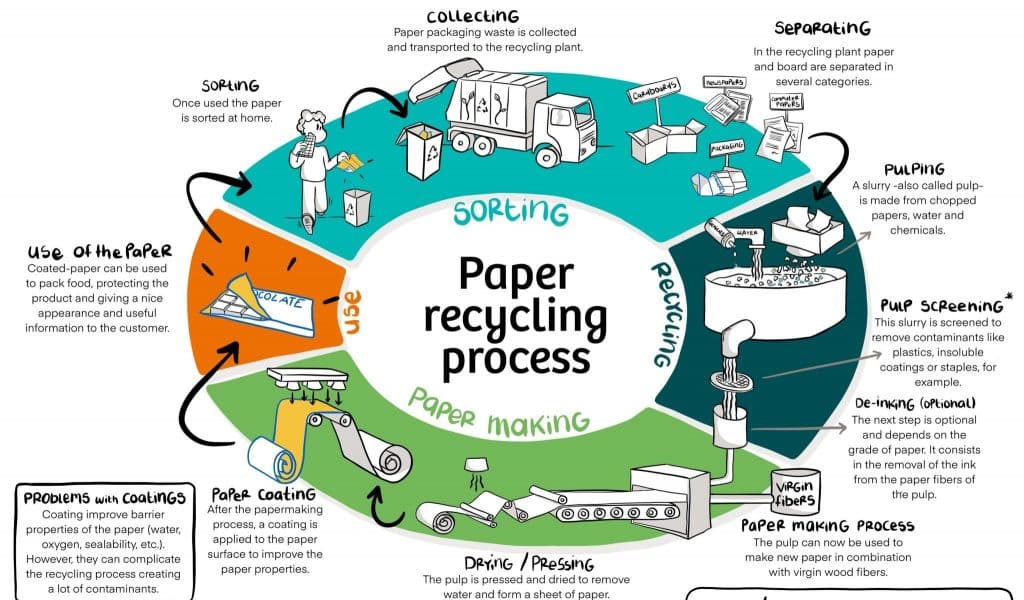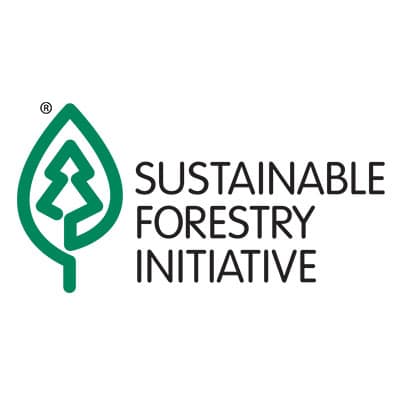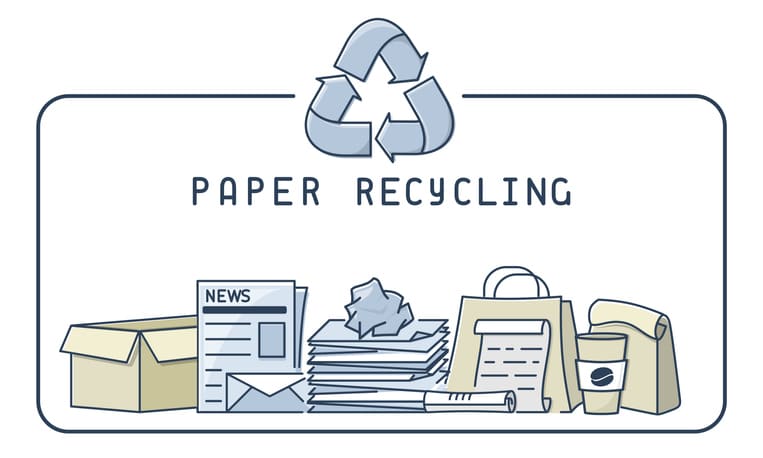If you are concerned about the usage of paper, its impact on the environment and what materials can or cannot be recycled, we have a considerable amount of information to discover regarding environmental initiatives in the paper industry.
| In 2022, the paper recycling rate was nearly 68%, which held approximately steady to the 2021 rate. Nearly half of recycled paper went into manufacturing containerboard – the material used to make cardboard boxes. |
Manufactured papers are generally composed of virgin fibres and a combination of recycled materials. In a few instances, paper may be composed of 100% recycled materials. Recycled products contain two types of recycled fiber – either post-consumer reclaimed material or pre-consumer reclaimed material. The two are fundamentally different, as specified in these definitions from the Forest Stewardship Council (FSC):
Post-consumer reclaimed material: Material that is reclaimed from a consumer or commercial product that has been used for its intended purpose by individuals, households or by commercial, industrial and institutional facilities in their role as end-users of the product.
Pre-consumer reclaimed material: Material that is reclaimed from a process of secondary manufacture or further downstream industry, in which the material has not been intentionally produced, is unfit for end use and not capable of being reused on-site in the same manufacturing process that generated it.
Post-consumer recycled paper embodies the circular economy – it is manufactured from recycled products that have served a purpose for end-users, then sold on the market where it again serves a useful purpose, and then can be recycled again. It goes to market and back in a sustainable manner.
Pre-consumer fiber, also known as post-industrial fiber, is recovered from paper used in industrial applications like printer overruns or newsstand returns. It does not reach end-users and it is not a full-fledged member of the circular economy, as it never serves a useful purpose in the consumer marketplace before it is recycled.
Only recycled paper made using post-consumer reclaimed material is sourced from recycling programs fed by the recycling bins filled with waste paper – magazines, newspapers, promotional materials, packaging, boxes, and office documents.

The environmental benefit of using post-consumer recycled paper outweighs that of using paper made from pre-consumer reclaimed materials. While the latter does re-use materials and strives to reduce environmental impact, the former is sustainable: it reduces the usage of virgin fiber, which means more trees for the world, re-uses materials which have been used by consumers – contributing to the development of a circular economy – and saves materials from being landfilled.
Paper cannot be recycled forever – wood fibers can be reused five to seven times as new products – so virgin fiber sourced from responsibly-managed FSC-certified forests remains an essential input for sustainable paper manufacturers.
| Conventional, or virgin paper is produced from tree pulp. Recycled paper is made, at least in part of paper, fiber or pulp. Recycling paper involves processes such as sorting, shredding, hydropulping and de-inking. whereas conventional paper production involves steps such as harvesting, debarking, chipping and mechanical or chemical pulping. Both processes use energy and emit greenhouse gases, but recycling uses less energy and results in lower greenhouse gas emissions. A piece of paper can be reprocessed roughly five to seven times before fibers are no longer viable. In addition to curbing emissions, paper recycling spares forests and reduces water waste. |
Sustainability Certifications
Among the 450 different sustainability standards, certifications, and eco-labels around the globe are those offered by the Forest Stewardship Council (FSC) and the Sustainable Forestry Initiative (SFI). While both organizations aim to promote sustainable forestry practices, each has their own distinct approaches and criteria. Let’s dive into some of the differences between FSC and SFI certifications, their importance, and their rising prevalence in the paper market.
FSC vs. SFI: What’s the Difference?
The primary purpose of the FSC and SFI certifications is to ensure responsible forest management practices, but they originated from different perspectives:

Forest Stewardship Council is an independent, non-profit organization that developed its certification system in response to concerns about deforestation and unsustainable logging practices. FSC certification focuses on maintaining and enhancing forest ecosystems, promoting biodiversity, as well as respecting the rights of indigenous communities and workers. FSC has established itself as the leading sustainability certification in the forest products industry. Its certification is widely recognized globally, and many major brands prefer FSC-certified paper to ensure responsible sourcing and reduce their ecological footprint.

Sustainable Forestry Initiative was established by the American forest sector to address sustainable forestry practices within North America. It aims to strike a balance between environmental, social, and economic considerations—emphasizing responsible forest management and supporting local communities. While SFI certification is prominent in North America, it is less prevalent on a global scale. However, SFI-certified paper products are still available and cater to customers who prioritize North American sourcing and sustainability standards.
In terms of certification criteria and requirements, both certifications share common goals but they differ in several key aspects:
Forest Management Standards: FSC certification sets comprehensive guidelines that cover various aspects of forest management, such as biodiversity conservation, protection of endangered species, and the prohibition of genetically modified organisms (GMOs). On the other hand, SFI certification places more emphasis on the economic viability of forestry operations and community engagement.
Chain of Custody: Both certifications provide chain of custody (CoC) certifications to ensure the traceability of forest products. FSC CoC certification ensures that wood-based products come from responsibly managed forests throughout the supply chain. SFI CoC certification focuses on verifying that fiber used in the manufacturing process comes from legal and responsible sources.
| The types of paper that cannot be recycled include – waxed paper, shredded paper, wrapping gift paper, paper coated with plastic, receipts, sticky paper, and any paper contaminated with food or other liquids like pizza boxes, milk & juice cartons, napkins & tissues, paper towels and toilet paper. |
Why SFI and FSC Labels Matter
In a world marked by environmental consciousness, certifications like those from FSC and SFI allow companies to distinguish themselves from competitors by demonstrating their commitment to responsible sourcing and sustainable practices. With consumer demand for sustainable products growing daily, sustainability certifications from FSC and SFI play a vital role in differentiating brands and products for consumers. Certified products appeal to environmentally conscious consumers who prioritize sustainability in their purchasing decisions. Consumers expect transparency and eco-friendly choices, and these certifications provide reassurance that the products they purchase align with their values.
SFI and FSC certifications also enable brands to access new markets and customers that prioritize sustainability. Many government agencies, educational institutions, and corporations have procurement policies that require or prefer certified products—creating opportunities for certified brands to expand their reach.
~ content in part from Ariva papers, keypointintelligence.com and drawdown.org ~

